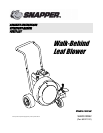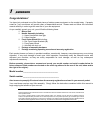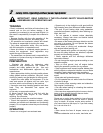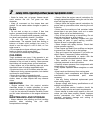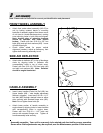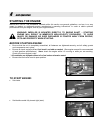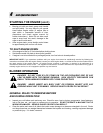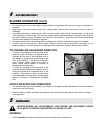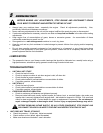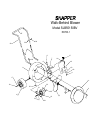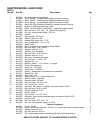
2
safety rules regarding outdoor power equipment (cont.)
• Watch for holes, ruts, or bumps. Uneven terrain
could overturn the unit. Tall grass can hide
obstacles.
• Keep all movement on the slopes slow and
gradual. Do not make sudden changes in speed or
direction.
Do Not
• Do not start or stop on a slope. If tires lose
traction, proceed slowly straight down the slope.
• Do not turn on slopes unless necessary, and then,
turn slowly and gradually downhill, if possible.
• Do not use near drop-offs, ditches, or
embankments. The operator could lose footing or
balance or blower could suddenly turn over if a
wheel is over the edge of a cliff or ditch, or if an
edge caves in.
• Do not operate on slopes with wet grass. Reduced
footing or traction could cause sliding.
• Do not use on excessively steep slopes.
CHILDREN
Tragic accidents can occur if the operator is not
alert to the presence of children. Children are often
attracted to the unit and its activity. Never assume
that children will remain where you last saw them.
• Keep children out of the blowing area and under
the watchful care of another responsible adult.
• Be alert and turn unit off if children enter the area.
• Before and during reverse operation, look behind
and down for small children.
• Never allow children to operate the unit.
• Use extra care when approaching blind corners,
shrubs, trees, or other objects that may obscure
vision.
EMISSIONS
• Engine exhaust from this product contains
chemicals known, in certain quantities, to cause
cancer, birth defects, or other reproductive harm.
• Look for the relevant Emissions Durability Period
and Air Index information on the engine emissions
label.
MAINTENANCE AND STORAGE
• Always observe safe refueling and fuel handling
practices when refueling the unit after
transportation or storage.
• Always follow the engine manual instructions for
storage preparations before storing the unit for both
short and long term periods.
• Always follow the engine manual instructions for
proper start-up procedures when returning the unit
to service.
• Never store the machine or fuel container inside
where there is an open flame, such as in a water
heater. Allow unit to cool before storing.
• Shut off fuel while storing or transporting. Do not
store fuel near flames or drain indoors.
• Keep all hardware, especially impeller bolt, tight
and keep all parts in good working condition.
Replace all worn or damaged decals.
• Never tamper with safety devices. Check their
proper operation regularly.
• Clean leaves and debris from mufflers and engine
to prevent fires. Clean up oil or fuel spillage.
• Stop and inspect the equipment if you strike an
object. Repair, if necessary, before restarting.
• Never make adjustments or repairs with the
engine running unless specified otherwise.
• Park machine on level ground. Never allow
untrained personnel to service machine.
• Carefully release pressure from components with
stored energy. (e.g. springs)
• Only replace impellers. Never straighten or weld
them.
• Keep hands and feet away from moving parts.
• Frequently check components and replace with
manufacturer’s recommended parts, when
necessary.
• Use only factory authorized replacement parts
when making repairs.
• Always comply with factory specifications on all
settings and adjustments.
• Only authorized service locations should be
utilized for major service and repair requirements.
• Never attempt to make major repairs on this unit
unless you have been properly trained. Improper
service procedures can result in hazardous
operation, equipment damage and voiding of
manufacturer’s warranty.



